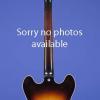Hawaiian-Etched Pattern Metal Body Resonator
Weighs 8.20 lbs. and has a fat nut width of 1 3/4 inches and a scale length of 24 3/4 inches. Chrome-plated bell brass body with Hawaiian etching on the top and the back, one-piece mahogany neck, and radiused rosewood fretboard with 19 frets and inlaid pearloid dot position markers. Headstock with decal "Dobro" logo. "Dobro" on pearloid plastic truss-rod cover. Individual Grover Roto-Matic tuners with half-moon metal buttons. Wooden bridge and Dobro tailpiece. Serial number ("B1109996") on the top edge of the headstock. This guitar is in mint (9.50) condition, apart from some very, very minuscule pitting to the metal. Housed in the original Dobro black hardshell case with black plush lining (9.50).
The original price in 1996 was $2,195.00, plus the cost of the case, and the price now is $2,860.00, including the case.
"It started out as a search for a louder guitar -- a guitar to stand up to the trumpets, saxophones and banjos that dominated popular music in the 1920s. George Beauchamp, a Los Angeles guitarist, took his vision of a mechanically amplified instrument to John Dopyera and his brother Rudy, Slovakian immigrants who had already patented several improvements for banjos. John Dopyera perfected a design utilizing three aluminum cones, Rudy suggested a metal body to enhance amplification, and the National tri-cone resonator guitar debuted in 1927. John Dopyera left National in 1928 and began developing a more affordable woodbody guitar with a single cone and a spiderlike bridge base. He introduced his new invention by the end of 1928 under the name DOBRO® -- a combination of Dopyera and Brothers (brothers John, Rudy, Emile, Robert and Louis would play various roles in the production and financing of the company). National responded with its own single-cone guitar, featuring a biscuitlike bridge base. After each side sued the other, they merged in 1932 to form the National-Dobro company. Although resonator guitars were initially well-received, the company quickly shifted its focus to the emerging electric guitar. National made no DOBRO® guitars after World War II, but several of the Dopyera brothers revived the spider-bridge resonator guitars under the DB Original brand. Family members formed the Original Musical Instrument company in 1967 and made resonator guitars under the Hound Dog brand until 1970, when they finally reacquired the DOBRO® name. Gibson Musical Instruments acquired O.M.I. in 1993, and became the Original Acoustic Instrument division of Gibson. Since then, O.A.I. has brought together all the best qualities of the original woodbody and metalbody resonator instruments, plus new models designed for slide guitar playing, into a modern line that offers a DOBRO® guitar for every musical style and taste. Whether the music is blues, Hawaiian, country, bluegrass, or a style of the future, DOBRO® guitars have the right sound" ("The Dobro® Story" at http://www.gibson.com/products/oai/dobro/story.html).
Translate:

